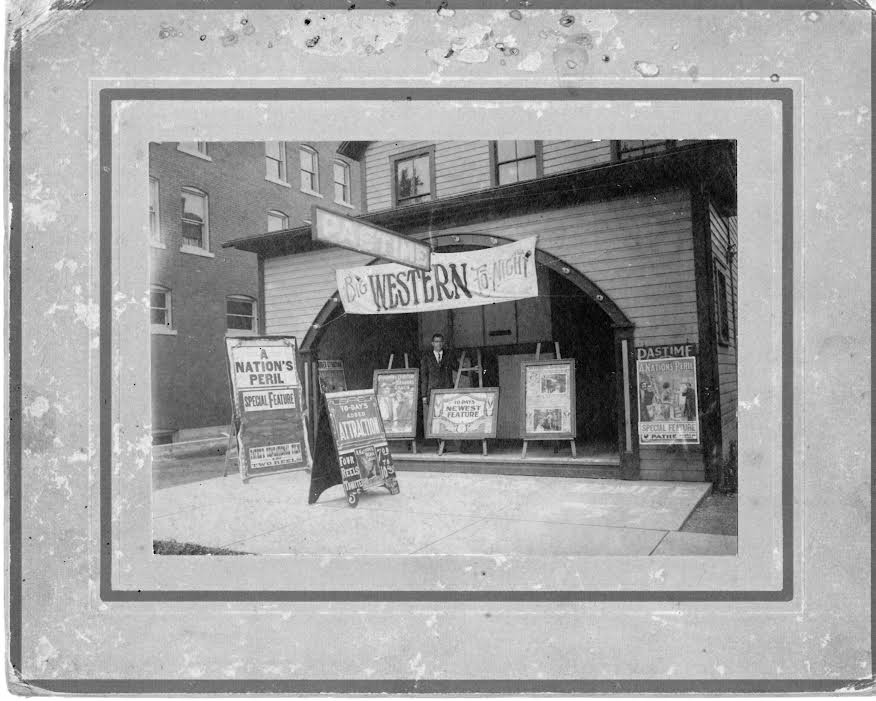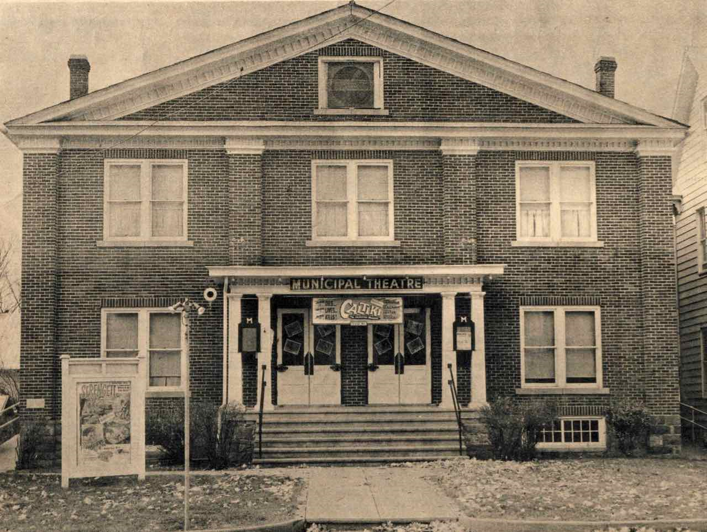Public motion picture screenings in Centre County paralleled the growth of the movies as a popular form of public entertainment in rural and small-town America in the first half of the 20th century, and their transformation to part of a wider range of entertainment in the late 20th and early 21st century.
It is likely that the first films shown in the county were presented by traveling showmen. Movies seem to have been shown casually in storefronts in the early 20th century. Certainly, some of the earliest screenings of motion pictures in Centre County took place in existing vaudeville houses, such as Bellefonte’s Garman Opera House, built in 1888 on East High Street.
During the nickelodeon era (so named because admission was 5 cents), existing storefronts were repurposed as movie theaters. The spaces typically had a capacity of fewer than 200, with temporary seating. Nickelodeons quickly exploded in popularity and geographic coverage. A nickelodeon theater in State College founded by two Penn State students opened in 1910 at the site of the former Bailey Carriage Shop. The Scenic Theater in Bellefonte opened around 1911 and could seat 400. It offered a program of several short films and admission was 5 cents. Another nickelodeon in Bellefonte, the Ritz, opened at an unknown date, but closed by 1829.

Theaters designed as movie-viewing spaces arrived with the Nittany Theatre, which seated 417, opening in 1912, and the Pastime Theater, which seated 350, two years later. Both these theaters were near the intersection of College Avenue and Allen Street. The Rowland Theatre opened in 1917 on North Front Street in Philipsburg. It was the region’s most opulent theater at the time and could seat up to 1,100 people.
Between 1920 and 1940, the largest and most ornate movie theaters opened in the county. State College’s Cathaum Theatre on College Avenue opened in 1926, with seating of 1,070. The opening of the State Theatre in 1938 on West College Avenue, seating over 500 patrons, fully integrated the State College market into the concentrated film distribution structure which prevailed in the U.S. after 1919.
The State, the Cathaum, and the Nittany were all affiliated with the Warner Bros. distribution organization. The State was used as a first-run “test house” to give Warners a sense of how its films would play to non-metropolitan audiences. The bills at the Cathaum, Nittany, and State frequently changed between two and six times per week, giving audiences a wide range of films to see. By 1940, State College’s three movie theaters could seat nearly 2,000 patrons collectively for each show in a town whose permanent population was only about 12,500, including Penn State students.
In Bellefonte, the Garman Opera House (sometimes also known as The State) became a film-only house in 1930, a transition typical of many small-town opera houses and vaudeville venues nationally. The Garman thus joined the 900-seat Richelieu (later known as the Plaza) in Bellefonte on High Street, built in 1925. The Majestic opened in 1935 in Philipsburg on North Front Street, with 450 seats.
Elsewhere in the county, the Milheim Theatre (sometimes called The Municipal), with 500 seats, opened in 1923 on Penn Street. The Clarence Theatre opened in 1931. Theaters in communities as small as Milheim and Clarence showed the extent to which movie-going had become central to rural life in these years.

During World War II, Centre County movie theaters were often focal points for community involvement in the war effort, with special screenings of war-related films, war bond sales, and “scrap matinees,” in which children brought scrap metal, said to be needed for the war effort, in exchange for a ticket, the theater absorbing the cost as a patriotic gesture.
New patterns of leisure brought changes to the motion picture experience in Centre County after World War II. The Baby Boom, an expanding car culture, and the growth of television all remade moviegoing. Catering to these trends, the Starlite Drive-In on Benner Pike opened in 1950 with capacity for 500 cars. The Nittany Lion Drive-In followed in Boalsburg, soon joined by the Temple Drive-In on North Atherton Street. The twin-screen Cinema 2 opened in State College in 1967 on Heister Street and in the early 1980s expanded to five screens as the Cinema 5.
The Nittany Theatre shifted in the late 1960s to a program alternating between European art films and X-rated films, a common schedule in college town theaters, including the State Theatre. This schizophrenic programming showed that in the age of television movies had become a niche entertainment choice.
As filmmaking and film studies courses appeared at Penn State, film culture became central to moviegoing. University film societies screened classic, foreign, and art films. The Twelvetrees was a small independent venue on South Atherton Street, named for silent film actress Helen Twelvetrees, which opened in 1966 to show art films and Hollywood classics. The success of the venue drew the attention of Associated Theaters, a regional theater chain, which purchased it in 1970 and renamed it The Flick.
The Screening Room, a tiny 100-seat venue on South Fraser in State College, featured second-run and X-rated films from the 1970s through the early 1980s. The Movies, also a small venue, opened on East Beaver Street, in 1972, and for several years drew overflow crowds of Penn State students every weekend with screenings of the cult-classic, The Rocky Horror Picture Show.

Meanwhile, theaters elsewhere in the county suffered declining revenues, deferred maintenance, and eventually closed. The Clarence Theatre closed in the mid 1950s. Philipsburg’s Majestic closed in 1960, while the Milheim Theatre struggled into the late 1960s before finally closing, although films continued to be shown occasionally into the 1980s.
National and regional chains, such as Associated Theatres, Cinemette, and Carmike Cinemas came to control several State College theaters beginning in the 1960s, seeking economies of scale. After closing in 1972, the Nittany Theatre reopened as the Garden Theatre in 1973, closing for good in 1986, while the Temple Drive-in closed in 1986, a victim of changing movie-viewing habits and suburban sprawl.
The first quarter of the 21st century saw film viewing migrate even more fully to the home. Centre County movie theaters explored new programming concepts or closed altogether. After being shuttered in in 1961, Bellefonte’s Garman Opera House reopened as an independent film theater in 2000. In 2008, the theater closed again, and the building housing it was destroyed by a fire in 2012.
When Cinema 5 closed in 2007, downtown State College lost its last dedicated movie house. The Starlite Drive-In closed in 2008. State College Carmike Cinema 6 on Benner Pike, closed in 2011. Multiplexing in Centre County continued into the 2000s with the opening of the UEC 12 on Premier Drive in 2004 and the College 9 on Carnegie Drive in 2008.
Today, the Rowland Theatre operates as a non-profit film and events theater. After struggling as a two-screen venue for several years, in 2006 the State Theater was restored and repurposed into a community performing arts center, whose programming includes independent and art films, as well as Penn State film studies courses.
Kevin Hagopian
Sources:
The Film Daily Yearbook, 1924-1970.
Centre Daily Times, October 14, 1938.
Cinema Treasures. www.cinematreasures.org (Accessed July 14, 2021).
Bowser, Eileen. The Transformation of the Cinema, 1907-1915. Berkeley: University of California Press, 1994.
Gomery, Douglas. Shared Pleasures: A History of Movie Presentation in the United States. Madison: University of Wisconsin Press, 1992.
Musser, Charles. The Emergence of Cinema: The American Screen to 1907. Berkeley: University of California Press, 1990.
First Published: August 24, 2021
Last Modified: March 7, 2024
